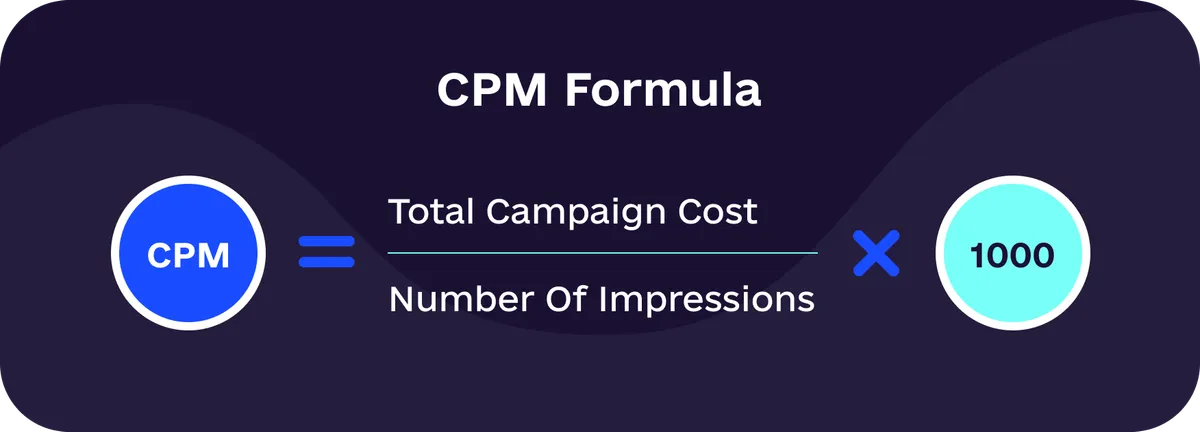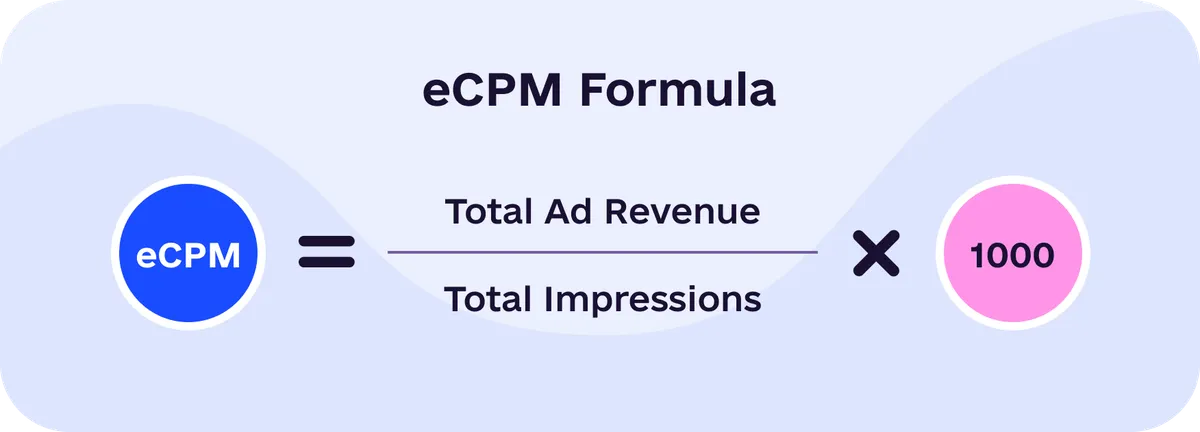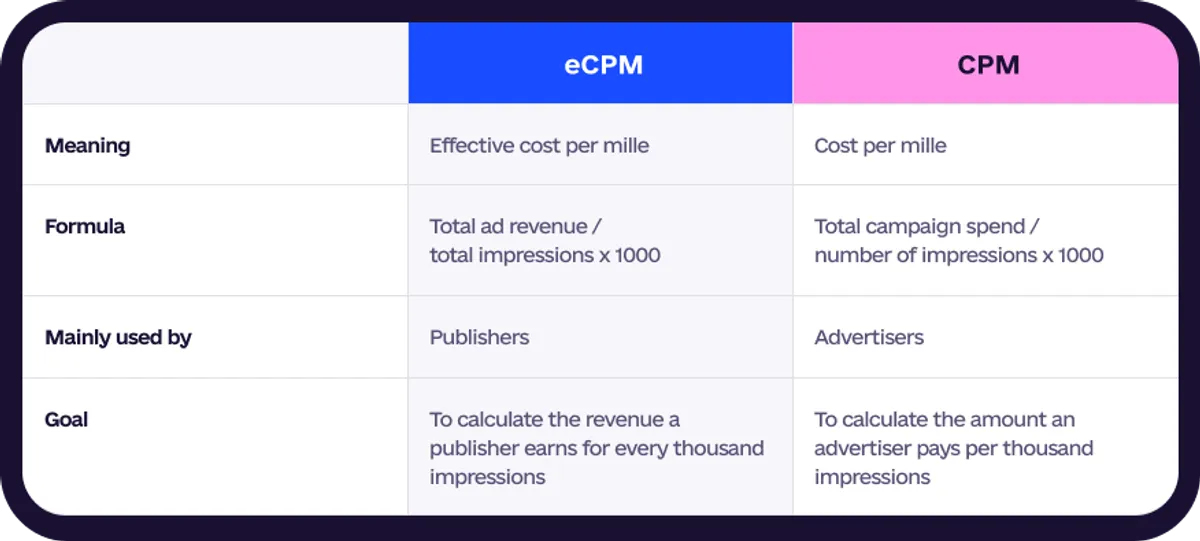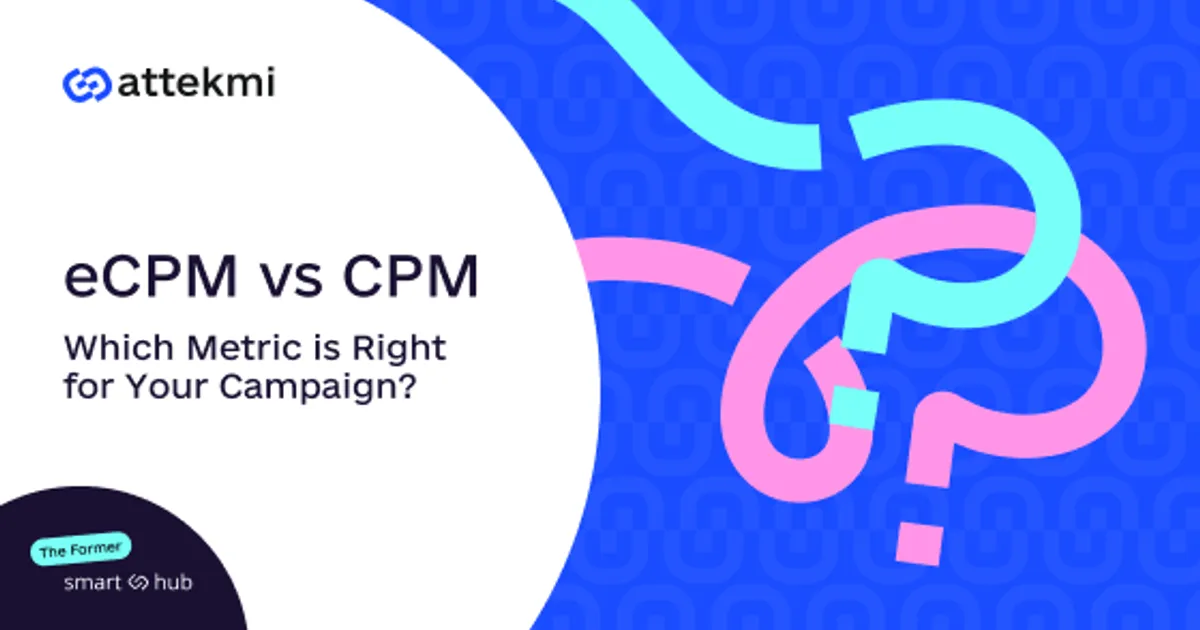The effectiveness of digital advertising heavily relies on continuous analysis, and eCPM and CPM are among the most common metrics tracked by publishers and advertisers to understand the performance of their campaigns. However, they are often confused with one another.
Operating in the AdTech industry since 2018, we understand the advertising ecosystem from A to Z. That is why we have prepared this guide – to clarify the difference between CPM and eCPM and explain how exactly these advertising metrics can be used by marketers and publishers. Read on to enhance your knowledge and discover what eCPM vs CPM is.
What is CPM?
Standing for “cost per mille”, CPM represents the cost per thousand impressions. For advertisers, that is a fixed price that they bid or pay for each thousand ad impressions. In turn, for publishers, CPM is the revenue they generate from every thousand impressions.
To calculate CPM, you need to divide the total cost of an ad campaign by the number of generated impressions and then multiply this figure by 1000. For instance, the campaign costs $400, and the number of impressions is 100,000. If we divide 400 by 100,000, we get 0.004. By multiplying this result by 1000, we get a CPM of $4.
Advertisers can also calculate CPM by dividing the total campaign budget by the expected number of impressions. The result should also be multiplied by 1000. If we use the example provided above one more time, this means that every publisher who sells their inventory for $4 or less will be able to display this marketer’s advertisement.
CPM formula
The CPM formula in digital marketing is as follows: you need to divide the total cost of an ad campaign by the number of generated impressions and then multiply this figure by 1000.

How to calculate CPM?
For instance, the campaign costs $400, and the number of impressions is 100,000. If we divide 400 by 100,000, we get 0.004. By multiplying this result by 1000, we get a CPM of $4.
Advertisers can also calculate CPM by dividing the total campaign budget by the expected number of impressions. The result should also be multiplied by 1000. If we use the example provided above one more time, this means that every publisher who sells their inventory for $4 or less will be able to display this marketer’s advertisement.
What is eCPM?
As for eCPM, that is effective CPM. It stands for “effective cost per mille” or effective cost per thousand impressions.It illustrates the revenue a publisher earns for every thousand impressions. The key difference is that eCPM is the average of multiple CPMs. While CPM can be used to calculate the income from every specific advertiser, eCPM allows publishers to understand the combined average of all bids. Basically, eCPM is the metric focusing exactly on publishers, while CPM is more related to advertisers.
The eCPM formula is as follows:
eCPM = (Total Ad Revenue / Total Impressions) x 1000
The formula for eCPM is as follows: the total ad revenue is divided by the total number of ad impressions and then multiplied by 1000. For example, the website served 300,000 impressions in one day, and the publisher earned $1,500 in total. In this case, eCPM would be $5. Advertisers can use the total ad spend instead of revenue.
Note that while CPM can be applied only to the CPM buying model, eCPM can be used in any context.
eCPM formula
The formula for eCPM is as follows: the total ad revenue is divided by the total number of ad impressions and then multiplied by 1000.

How to calculate eCPM?
For example, the website served 300,000 impressions in one day, and the publisher earned $1,500 in total. Divide 1,500 by 300,000, then multiply the result by 1000 – eCPM would be $5. Advertisers can use the total ad spend instead of revenue.
Note that while CPM can be applied only to the CPM buying model, eCPM can be used in any context.
Key differences between eCPM vs CPM
So, eCPM vs CPM. Let’s summarize the key differences:

Keep in mind that effective eCPM (or “good” eCPM), as well as the right CPM, highly depend on an entire range of factors, including ad format, target audience, etc.
When to use CPM vs. eCPM?
Now that the difference between CPM vs eCPM is clarified, let’s explore how these metrics can be used by advertisers and publishers.
When should you use CPM as an advertiser?
CPM is among the key metrics for advertisers due to the following reasons:
Advertisers can use CPM to compare the cost-effectiveness of different campaigns or placements to understand which drives the most impressions for the lowest price.
The metric allows marketers to identify the cost of reaching their audience, which is essential for budget planning.
Tracking CPM is also a way to find out how effectively an advertiser builds brand awareness.
Note that publishers can also use CPM to track and optimize their ad revenue. By calculating CPM, they can identify high-value marketers willing to pay premium prices for the inventory, find out what formats are the most effective, and make data-driven decisions regarding their strategies. As a result, tracking both CPM and eCPM is a more effective way to maximize strategy performance.
When is eCPM the right metric for publishers?
Now, let’s switch to eCPM, a crucial metric for media owners. Here is why eCPM for publishers should be tracked:
With eCPM, publishers can evaluate the overall profitability of the website.
The metric can be used to forecast future income.
The metric allows for comparing the performance of different pages or websites (when applicable).
It enables publishers to set floor prices in a more effective way.
Additionally, if a publisher uses several ad platforms, tracking eCPM allows them to identify the most efficient solution.
Even though eCPM is mainly publishers’ metric, advertisers can also use it to measure the overall effectiveness of their campaigns. Tracking both CPM and eCPM allows for a more comprehensive view.
How eCPM and CPM fit into programmatic advertising
Now, let’s take a look at a couple of real-world cases to provide you with a better understanding of eCPM vs CPM and how these metrics can be applied.
An advertiser is going to launch a large-scale brand awareness campaign:
They know the campaign budget and the estimated audience size. After calculating CPM, they get the result of $5.
Therefore, considering this, they can set up a bid price that is convenient for them and applicable to their budget – this is done via a demand-side platform.
Without knowing potential CPM, an advertiser risks overpaying and going beyond budget limits or losing an opportunity to access premium inventory.
Then, by continuously analyzing the real CPM after launching the campaign, an advertiser can make sure that everything goes as planned or timely react to any issues.
Now, let’s review a case for a publisher who wants to identify the most profitable advertisers and build stronger connections with them:
This can be done by calculating CPM.
Then, after the high-value marketers are detected, a publisher may want to contact them and offer, for instance, guaranteed deals that will enable both the publisher and the marketers to bypass traditional real-time bidding auctions.
And here comes a scenario for eCPM. For example, a publisher is going to review their monetization strategy and find optimization opportunities:
After checking eCPM rates for different months, they discover that there is a higher demand for ad inventory during the Christmas and Black Friday periods, and marketers tend to increase ad spending.
With this knowledge in mind, a publisher can adjust floor prices during the mentioned time frames (via a supply-side platform) and, as a result, effectively monetize remnant inventory and drive income.
Marketers willing to optimize their strategies and maximize the performance of their ad campaigns can also use eCPM as one of the metrics when looking for opportunities, and, therefore, track both CPM and eCPM. However, for them, CPM is still more important to track.
CPM is among the most crucial metrics provided by demand-side platforms (DSPs), while eCPM is one of the key metrics tracked by supply-side platforms (SSPs). However, these platforms are not the only participants in the programmatic advertising ecosystem. By operating an ad exchange solution and matching the right demand with the right supply, you can earn from media trading.
Consider Attekmi your trusted partner
At Attekmi, we are ready to help you launch your own marketplace in the shortest time possible, and our range of ad exchange solutions and services is able to meet any needs.
Attekmi’s ad exchange platforms
AdEx Basic: an entry-level ad exchange solution with basic functionalities.
AdEx Plus: an enhanced version of AdEx Basic.
AdEx Enterprise: a platform with advanced functionality and an ultimately scalable nature
White Label Ad Exchange: a fully customizable solution, from UI personalization to custom on-request feature development.
Note that getting your own ad exchange can help you optimize eCPM or CPM since you gain greater control over the processes.
Attekmi’s services
Custom AdTech development: We are ready to bring your project to life.
Ad Ops outstaffing: We can train an expert for your business so that you can focus on your core operations.
AdTech and Ad Ops training: We are here to help you enhance your skills.
Boost your CPM and eCPM with programmatic advertising
Programmatic technology revolutionized the digital advertising landscape. When everything is set up correctly, advertisers can reach exactly those users who are most likely to get interested in their products or services. In turn, publishers can monetize their inventory effectively. Auctions happen automatically, and the whole process takes just a couple of seconds. Therefore, switching to the programmatic approach is a way to optimize CPM and eCPM.
However, publishers and marketers are not the only ones who can benefit from this technology. Using Attekmi solutions, you can enter the programmatic environment quickly and start earning on media trading by connecting demand and supply partners.
Offer a reliable ad exchange to your partners and maximize your revenue with Attekmi. Contact us.
FAQ
It is effective cost per mille vs cost per mille. Being the average of multiple CPMs, the first metric illustrates revenue received for a thousand impressions, and the second one — cost per thousand impressions. CPM is typically tracked by advertisers, while eCPM is tracked by publishers. Additionally, eCPM applies to any buying model, while CPM applies only to CPM.
CPM is considered an advertiser-focused metric, while eCPM is typically used by publishers. Keeping your goals in mind is a way to make a choice. However, to get a better understanding of the website or campaign performance, publishers and marketers can track both metrics instead of choosing between eCPM vs CPM.
Monitoring CPM and eCPM is essential, but there are many other metrics to consider for making effective data-driven decisions. For instance, advertisers should also keep an eye on clicks, cost per click, conversions, etc. In turn, publishers need to monitor ad fill rates, analyze the performance of their websites to keep them efficient, and so on.
 By Roman Vrublivskyi
By Roman Vrublivskyi

